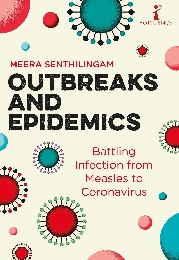Outbreaks and Epidemics: Battling Infection from Measles to Coronavirus

Meera Senthilingam
Icon Books, £8.99
Health journalist and researcher Meera Senthilingam's book is a well-timed introduction to the study of infectious disease, and an account of humanity's attempts to come to terms with such diseases. Published just as the Covid-19 pandemic was emerging, the world's current pre-occupation with SARS-CoV-2 gets only passing mentions, and mainly in connection to previous outbreaks of coronaviruses such as SARS-CoV-1 and MERS.
The book surveys a range of diseases, current and historical, and a common theme is the social and political dimensions that are apparent in disease distribution, attempts to prevent transmission, and treatment. While diseases such as malaria, HIV, and Ebola are all covered, I was most interested in the brief sections concerning diseases about which I knew less, such as chikungunya, yaws, and West Nile virus.
For more casual readers, there is a useful primer on key terms, helpfully distinguishing outbreaks from epidemics from pandemics, for example. Such clarification is helpful for non-specialists following news about the current pandemic, but also in understanding historical literature about past diseases, and any future emerging infections.
A prescient chapter is that on ‘Disease and Politics’, with its consideration of the anti-vaccination movement. The tensions between individual autonomy and community health are discussed, and some arguments over persuasion versus compulsion with regards vaccination initiatives are presented, as well as taking account of some of the factors that affect vaccine uptake generally.
Senthilingam points out that while there have been success stories in terms of disease eradication (i.e smallpox), and elimination in many countries (polio), vigilance is still essential for many other infectious diseases. HIV remains a pressing concern, with as many as 38 million people requiring antiretroviral drug treatment currently, with many cases in East and Southern Africa, but also with relatively recent spikes in Eastern Europe and Central Asia. Malaria, a disease with an unequal distribution, still infects over 200 million annually, despite progress in case reduction in the first decade of this century.
The book is well-written, and there is much of value to a lay audience and non-specialists. It also serves as a useful reminder that while the world’s gaze is directed, understandably, at Covid-19, it’s important that we remember that whatever the future regarding SARS-CoV-2, infectious diseases are here to stay. As the title of the penultimate chapter says, “I’m not going anywhere”.
Conor McCrory MRSB


